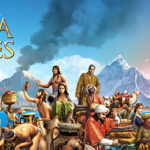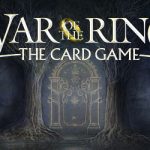Aeterna is a historical-themed game with strategic depth and engaging gameplay. Created by the acclaimed game designer Martin Wallace, Aeterna was developed by Ergo Ludo Editions. In this article, Roberto Martire and Lorenzo Maria Conti, developers from the Ergo Ludo team, tell us about their work on Aeterna, and the story behind the game.
"Aeterna takes you on a long journey through the ancient city of Rome (so wear comfortable shoes). It will take you from its beginnings in 753 BC to the fall of the Western Roman Empire in 476 AD. The players assume the role of important Roman GENS (families) who seek to increase their prestige by contributing to the construction of monuments, the conquest of provinces, and, above all, by controlling and managing the seven hills on which the eternal city was founded.
The game features a structure of three rounds, symbolizing the three eras of Roman history: the Roman Kingdom, the Roman Republic, and the great Roman Empire. Players must wisely balance the mechanics of drafting, card usage, resource management, and area control on the map to assert their dominance over the city. In addition, the timing of your actions could make the difference between victory and defeat. Contrary to what Caesar said when crossing the Rubicon, luck plays almost no role, and the interaction between players is strong, albeit indirect.
During the turn, players face an initial drafting phase, in which they plan what to do, and then start the action phase, the true core of the game. Players will use their citizens to secure strategic points on the city map or to conquer new provinces. Both the city and the provinces will provide them with resources such as grain, coins, and stone, essential for building monuments that, in turn, attract new citizens. This creates a cycle aimed, in a very symbolic and simplified manner, at reconstructing how the city grew from a few clusters of huts to the “Urbe” of the late empire. However, this growth needs to be harmonious and balanced. An overpopulated city or one afflicted by food shortages will inevitably lead to riots and destruction, for which players will be held responsible.
A short history
The project was born in 2014, when the CEO of Ergo Ludo Editions, Alessandro Lanzuisi, proposed a collaboration to the already renowned Martin Wallace, author of titles like “Steam”, “Brass”, and “Struggle of Empires”. There was the desire to work together even before the definitive idea had taken shape and the theme itself was not clear from the outset. Discussions began with the Italian Unification (Risorgimento) and gradually moved back in time until they arrived in Rome several centuries before year 0. Wallace then began his design work, and in October 2019, during the Essen game fair, he presented to Ergo Ludo the first prototype of "Ancient Rome." The game was complete but, according to Wallace himself, in need of "fine tuning." The game thus officially entered Ergo Ludo's editorial schedule.
Due to the pandemic, the work proceeded slowly but steadily, thanks to the strong motivation of the development team to work on a game by such a beloved author. Test after test, the gameplay improved: the duration was slightly shortened (a maximum of 30 minutes per player), the game resources optimized, and some mechanics changed. Over time, the name also evolved, first to "Caput Mundi" and finally becoming AETERNA in its definitive version. By February 2022, the game was substantially ready.
When everything seemed finished, another work began. A lengthy process of historical contextualization in a setting that is both so well-known and so unknown at the same time. Buildings, monuments, and characters must be correctly placed within over 1,000 years of Roman history, balancing certain sources and more or less accredited theories. Thus, guides, professors, and Latinists joined the development team.
The next phase was the aesthetic realization, with the contributions of the artists Andreas Rocha (“Monumental”) and Emiliano Mammucari (“Cangaceiros”) and graphic designer Marco Pantaleoni (“Pyramidice”). In the end, the project saw the collaboration of over 10 people from both internal and external staff, not to mention the 50 playtesters who contributed numerous sessions over the years.
Now, five years after that Essen where prototype zero entered our lives, we are finally seeing the printing and completing of this project to which we have devoted so much time and resources."
* This article was originally published by Game Trade Magazine, Issue 294 (August 2024).














